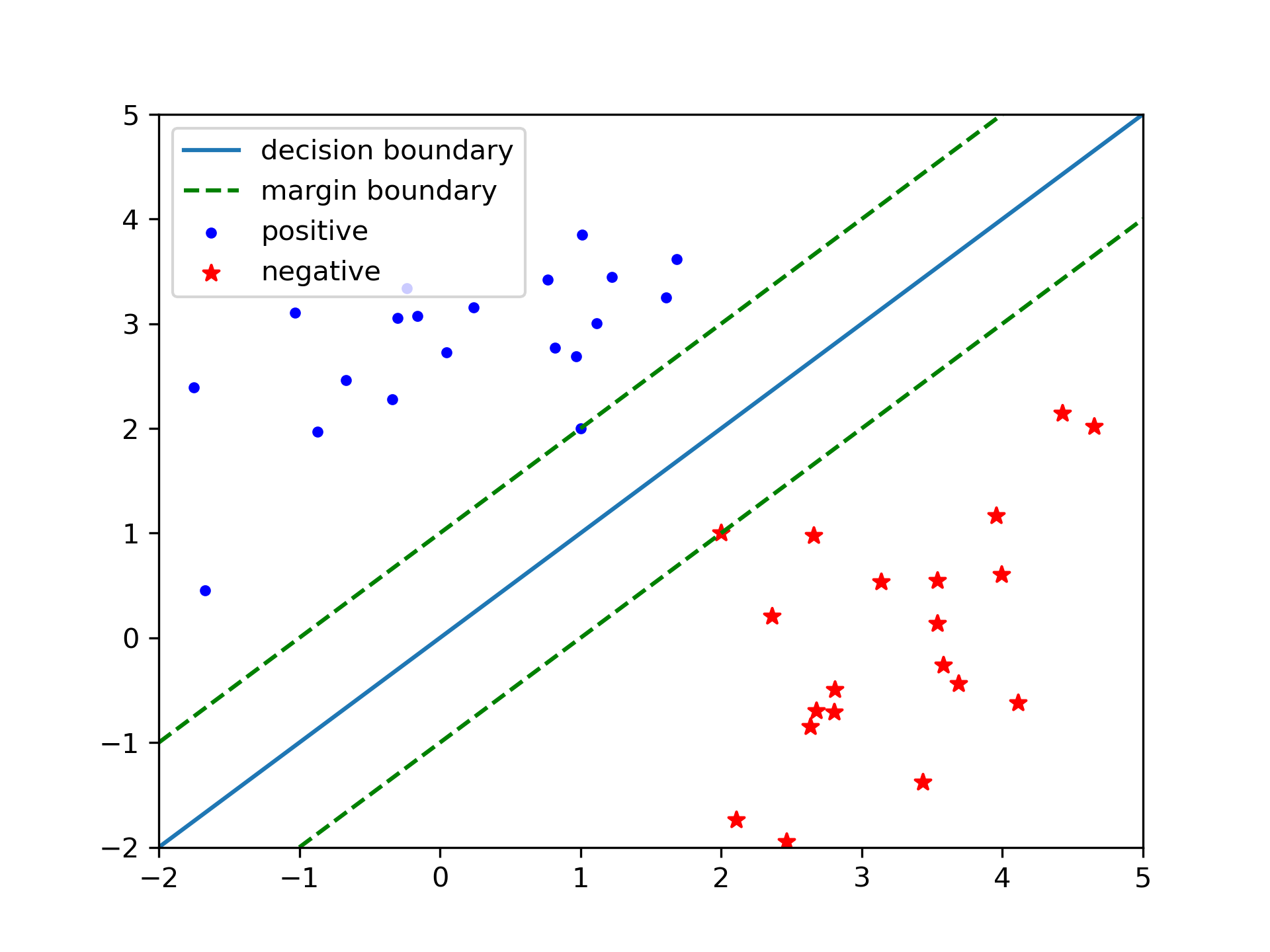Linear SVM
Note
The intuition behind Support Vector Machine(SVM) is to separate positive&negative samples by large margins.
Margin
Suppose we have a binary classification problem with \(x \in \mathbb{R}^{d}, y \in \{-1, 1\}\). Try to solve this by linear classifier \(h(x) = w^{T}x + b\), if \(h(x) >= 0\) predict 1, else -1. Intuitively, in addition to correctly separate the data, we want to separate the data by large margins.

Geometric margin of the classifier:
\[\gamma^{(i)}=\frac{y^{(i)}(w^{T}x^{(i)} + b)}{\left \| w \right \| }\]
We want to maximize geometic margin:
\[\begin{split}
\begin{equation}
\begin{split}
\underset{\gamma, w, b}{\max}\ &\gamma \\
\mbox{s.t.}\ &\frac{y^{(i)}(w^{T}x^{(i)} + b)}{\left \| w \right \| } >= \gamma
\end{split}
\end{equation}
\end{split}\]
Without loss of generality, set \(\gamma\left \| w \right \|=1\), then the above is equivalent to:
\[\begin{split}
\begin{equation}
\begin{split}
\underset{w, b}{\min}\ &\frac{1}{2}{\left \| w \right \|}^2 \\
\mbox{s.t.}\ &{y^{(i)}(w^{T}x^{(i)} + b)} >= 1
\end{split}
\end{equation}
\end{split}\]
Dual Problem
We can write the constraints as:
\[g_{i}(w) = 1 - y^{(i)}(w^{T}x^{(i)} + b) \le 0\]
The generalized Lagrangian of the above optimal problem:
\[
L(w,b,\alpha )=\frac{1}{2}\left \| w \right \|^{2} + \sum_{i=1}^{n}\alpha_{i}\left [ 1 - y^{(i)}(w^{T}x^{(i)} + b) \right ]
\]
Primal problem:
\[\underset{w, b}{\min}\ \underset{\alpha_{i}\ge0}{\max}\ L(w, b, \alpha)\]
The KKT condition:
\(\frac{1}{2}\left \| w \right \|^{2}\) is convex.
\(g_{i}\)’s are convex.
the constraints \(g_{i}\)’s are strictly feasible.
is satisfied in the separable case, so the primal problem is equivalent to the dual problem:
\[\underset{\alpha_{i}\ge0}{\max}\ \underset{w, b}{\min}\ L(w, b, \alpha)\]
Minimize \(\nabla_{w}L(w, b, \alpha)\):
\[\nabla_{w}L(w, b, \alpha) = w - \sum_{i=1}^{n}\alpha_{i}y^{(i)}x^{(i)} = 0 \Rightarrow w = \sum_{i=1}^{n}\alpha_{i}y^{(i)}x^{(i)}\]
\[\nabla_{b}L(w, b, \alpha) = \sum_{i=1}^{n}\alpha_{i}y^{(i)}=0\]
Plug back to Lagrangian:
\[\begin{split}
\begin{equation}
\begin{split}
L(w, b, \alpha) =& \frac{1}{2}\left \| w \right \|^{2} + \sum_{i=1}^{n}\alpha_{i}\left [ 1 - y^{(i)}(w^{T}x^{(i)} + b)\right ]\\
=& \sum_{i=1}^{n}\alpha_{i} - \sum_{i,j=1}^{n}y^{(i)}y^{(j)}\alpha_{i}\alpha_{j}(x^{(i)})^{T}x^{(i)}
\end{split}
\end{equation}
\end{split}\]
Dual problem:
\[\begin{split}
\begin{equation}
\begin{split}
\underset{\alpha}{\max}\ &\sum_{i=1}^{n}\alpha_{i} - \sum_{i,j=1}^{n}y^{(i)}y^{(j)}\alpha_{i}\alpha_{j}\left \langle x^{(i)},x^{(j)} \right \rangle \\
\mbox{s.t.}\ &\alpha_{i}\ge{0}, i=1,...,n \\
&\sum_{i=1}^{n}\alpha_{i}y^{(i)}=0
\end{split}
\end{equation}
\end{split}\]
Non-separable Case
For non-separable case, we add the soft term \(\xi\), thus transform the optimization:
\[\begin{split}
\begin{equation}
\begin{split}
\underset{w, b}{\min}\ &\frac{1}{2}{\left \| w \right \|}^2 + C\sum_{i=1}^{n}\xi_{i}\\
\mbox{s.t.}\ &{y^{(i)}(w^{T}x^{(i)} + b)} >= 1 - \xi_{i},\ i=1,...,n\\
&\xi_{i} \ge 0,\ i=1,...,n.
\end{split}
\end{equation}
\end{split}\]
Lagrangian:
\[
L(w,b,\xi,\alpha,r )=\frac{1}{2}\left \| w \right \|^{2} + C\sum_{i=1}^{n}\xi_{i} + \sum_{i=1}^{n}\alpha_{i}\left [1 - \xi -y^{(i)}(w^{T}x^{(i)} + b)\right ] -\sum_{i=1}^{n}r_{i}\xi_{i}
\]
Dual problem of the non-separable case:
\[\begin{split}
\begin{equation}
\begin{split}
\underset{\alpha}{\max}\ &\sum_{i=1}^{n}\alpha_{i} - \sum_{i,j=1}^{n}y^{(i)}y^{(j)}\alpha_{i}\alpha_{j}\left \langle x^{(i)},x^{(j)} \right \rangle \\
\mbox{s.t.}\ &0 \le \alpha_{i}\le{C},\ i=1,...,n \\
&\sum_{i=1}^{n}\alpha_{i}y^{(i)}=0
\end{split}
\end{equation}
\end{split}\]
Examples
Pipeline(steps=[('standardscaler', StandardScaler()),
('linearsvc', LinearSVC(random_state=0, tol=1e-05))])
array([[0.14144316, 0.52678399, 0.67978685, 0.49307524]])
SMO algorithm
We can not directly use coordinate ascent in SVM:
\[\begin{split}
\begin{equation}
\begin{split}
\underset{\alpha}{\max}\ &\sum_{i=1}^{n}\alpha_{i} - \sum_{i,j=1}^{n}y^{(i)}y^{(j)}\alpha_{i}\alpha_{j}\left \langle x^{(i)},x^{(j)} \right \rangle \\
\mbox{s.t.}\ &0 \le \alpha_{i}\le{C},\ i=1,...,n \\
&\sum_{i=1}^{n}\alpha_{i}y^{(i)}=0
\end{split}
\end{equation}
\end{split}\]
If we want to update some \(\alpha_{i}\), we must update at least two of them simutaneously, coordinate ascent change to:
select some pair \(\alpha_{i}, \alpha_{j}\).
optimize with respect to \(\alpha_{i}, \alpha_{j}\) while holding other \(\alpha_{k}\) fixed.
We can easily change step-2 into a quatratic optimization problem.
Remaining the choice of \(\alpha_{i},\alpha_{j}\) , in fact this step is heuristic.

